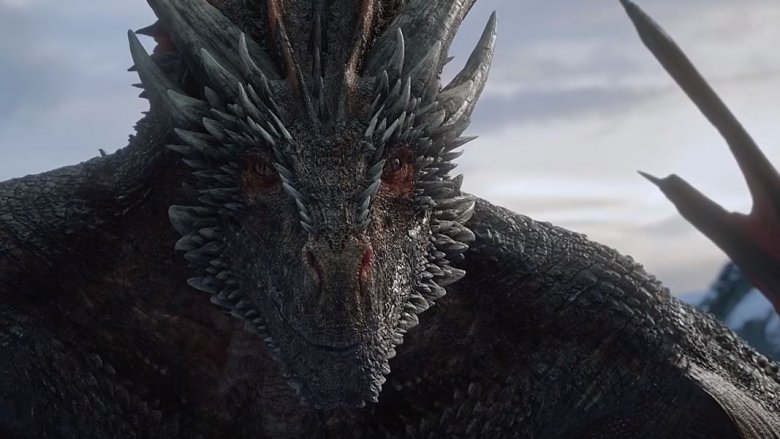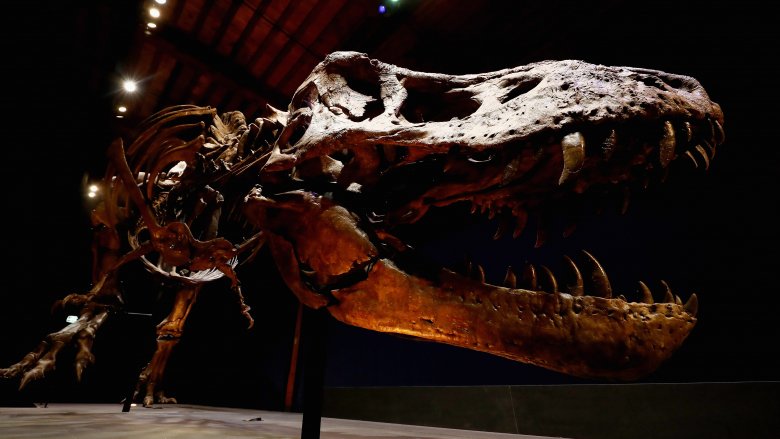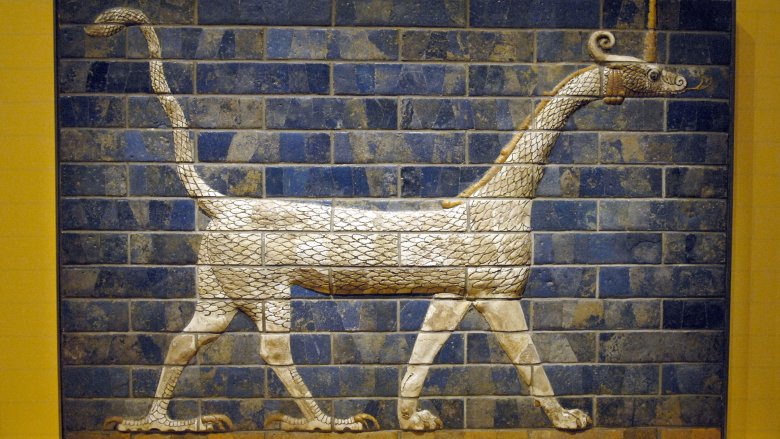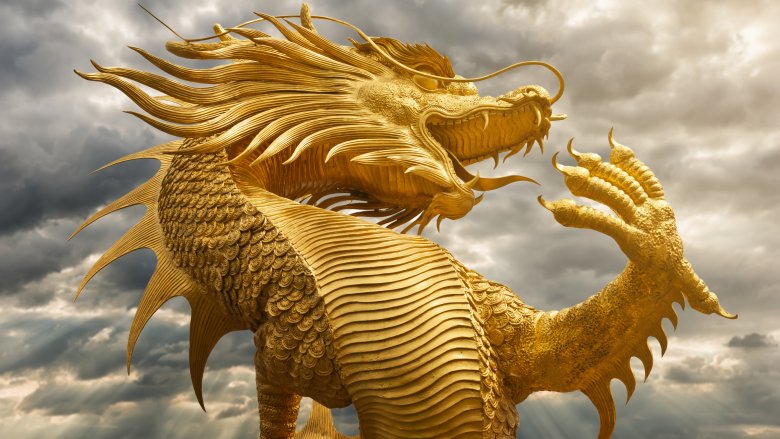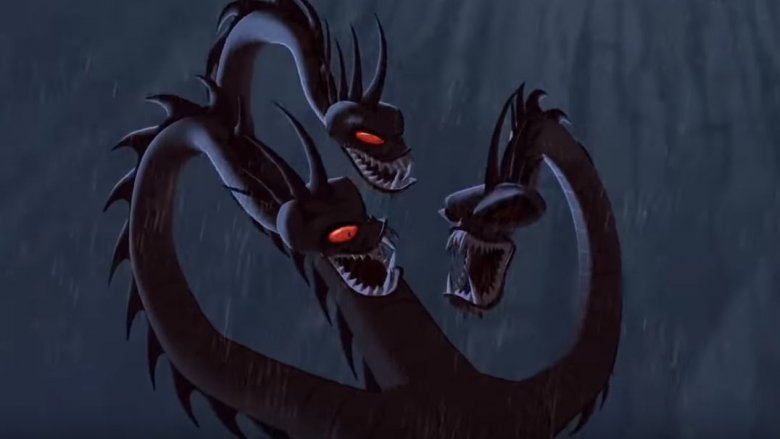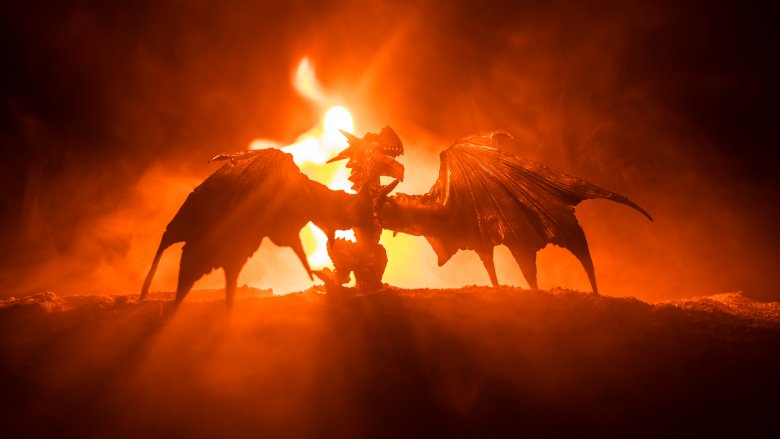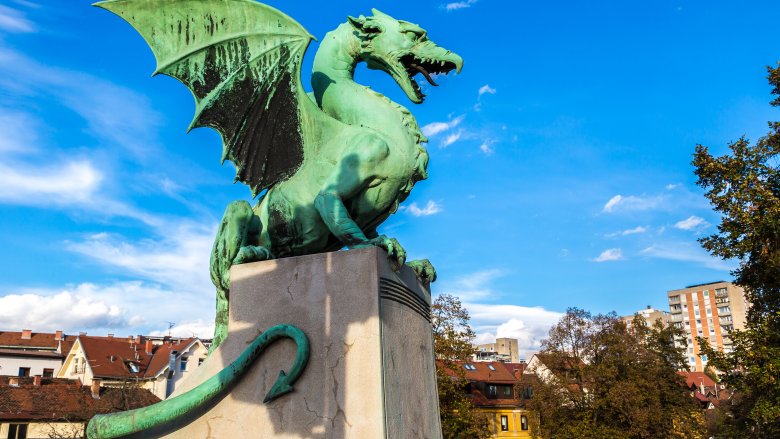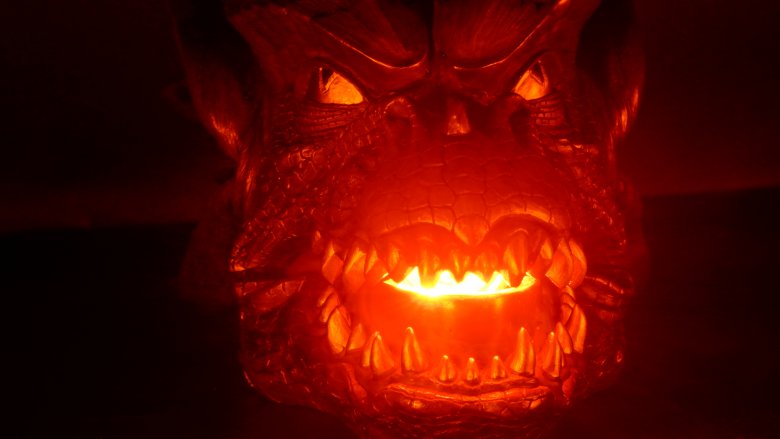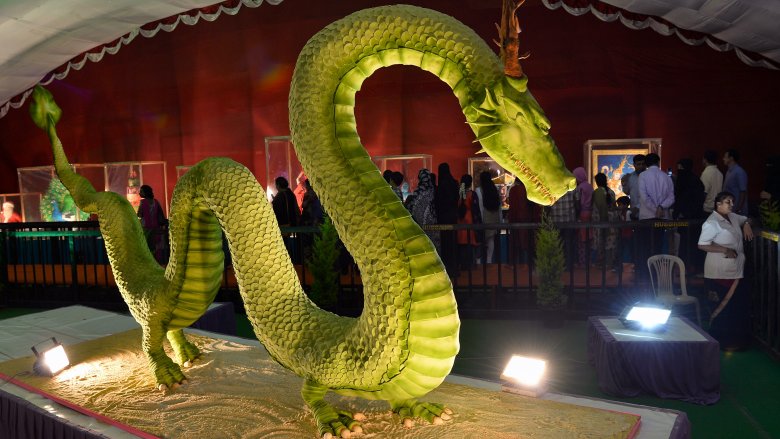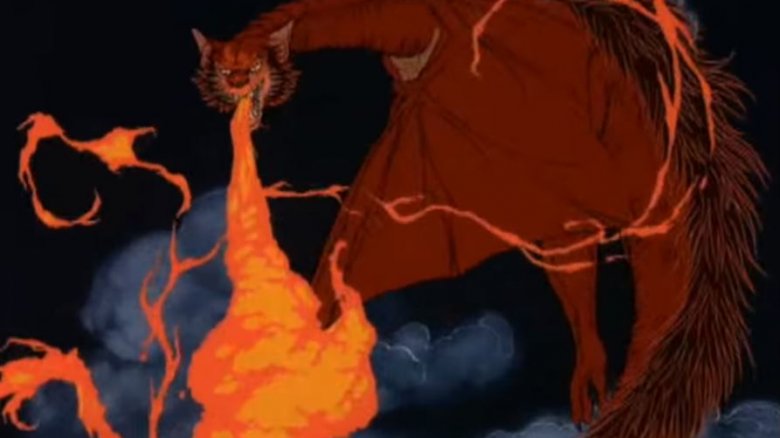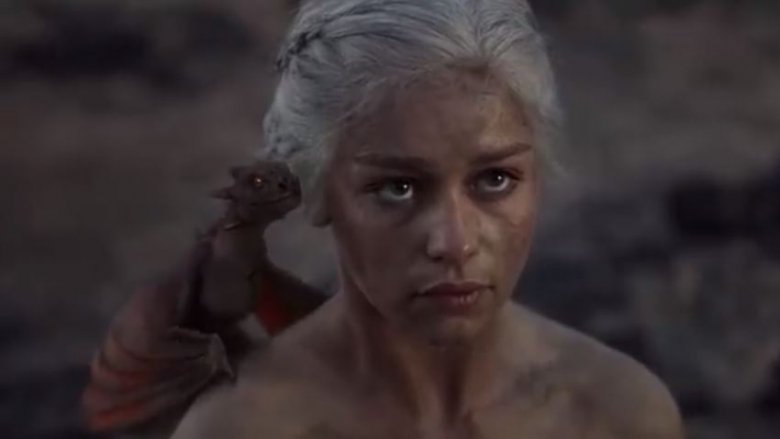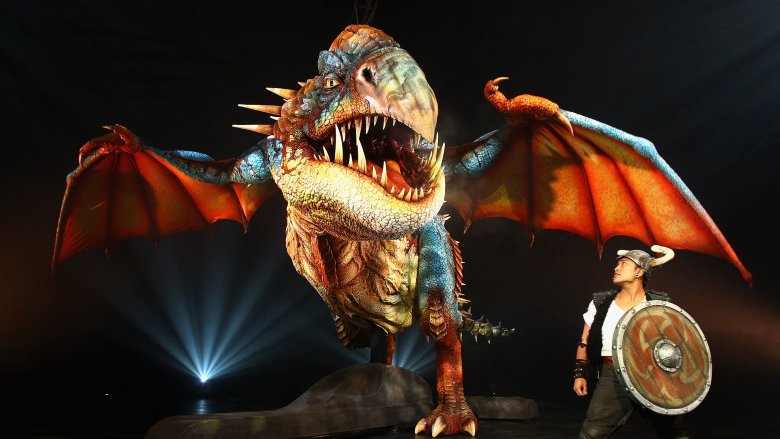The Untold Truth Of Dragon Mythology
Whether you're getting tangled up in the nightmarish politics of Westeros or trekking across the globe over some magical ring, one thing is consistent in every fantasy mythology, ever: Dragons are total BAMFs. There might be nothing more terrifying than some giant, winged reptile scorching the countryside ... except for, you know, a Khaleesi crazy enough to ride on top of one.
Unfortunately, dragons can't be found in the real world, but the mythology surrounding these fabled beasts goes all the way back to the beginning of humanity itself. For as long as we've been around, humans have awed, worshiped, and/or feared the might of dragons. Countless ancient cultures had different dragon stories, yet the basic concept of these creatures is shockingly consistent across continents and through time. The scaly monsters are certainly a big part of history, but where did dragons come from? Here's what we know about dragons.
Blame the dinosaurs
Probably the weirdest thing about dragons is just how many different cultures have their own take on the legend, whether they interacted with each other or not. For example, while everybody knows about the Chinese and European varieties, stories about dragon-like creatures stretch all the way to South America, according to the Handbook of Inca Mythology. Such extra-continental consistency is strange enough to almost make a person wonder: Could it be that dragons were once, perhaps, living animals?
Of course not. That said, a real species of "terrible lizards" did once stomp around the Earth, leaving lots of fossils in their wake. And, naturally, they looked a lot like dragons.
Many paleontologists and historians have proposed that early dragon legends were probably inspired by dinosaur remains, according to the Stanford Humanities Center, with one particular expert being Adrienne Mayor. Her book on the subject points out that there are written records of Chinese "dragon" bones being dug up as far back as the second century B.C., and that later research into the dragon bones used for traditional medicines has uncovered new species of dinosaurs. CNN reported that Chinese farmers discovered the remains of a long-necked dinosaur named "Qijianglong" in 2006, and its head and neck look remarkably similar to a traditional Chinese dragon. Considering how many mysteries still remain regarding how dinosaurs looked and behaved, it's no wonder that early people came up with wild stories.
There might be living inspirations, too
All those fossils provide the easiest explanation for dragon legends. On the other hand, there are plenty of living animals that — with the help of some exaggeration from the locals — may have also played a key role in developing the various dragon myths around the world, even if they don't have the massive size of a Brachiosaurus or the flapping wings of a pterodactyl.
The most obvious example is the Komodo dragon. Heck, they even have the word dragon in their name. These massive monitor lizards can certainly scare the innards out of people who haven't seen them before, and according to the BBC, the iconic phrase "Here be dragons!" might've originated from the tales of Chinese sailors in the 1500s and before, telling other explorers to beware the scary creatures found on certain Indonesian islands. Adrienne Mayor, though largely a proponent of the fossil theory, also argues that exaggerated tales of real creatures like alligators, Gila monsters, and iguanas probably encouraged dragon myths to flourish.
All roads go back to Mesopotamia
For some reason, dragons seem much more important than other fantasy creatures. Sure, unicorns are elegant and impressive, but dragons? C'mon, it's not a contest. Perhaps the world's enduring fascination with dragons has something to do with the fact that myths regarding giant, winged, reptilian beasts (usually with magical powers) go back all the way back to the origins of human civilization in ancient Mesopotamia, according to the University of Pennsylvania. It is believed that the head god of the Mesopotamian pantheon was Marduk, the patron deity of Babylon. In early artwork, Marduk was symbolized by a serpentine dragon called the "mušḫuššu," whose temperament could range from benevolent to destructive, depending on his mood. That sounds like a dragon.
Mesopotamian artwork and poetry depicted other types of dragon, as well, according to the dictionary Gods, Demons, and Symbols of Ancient Mesopotamia, including the Ušumgal. These early dragons symbolized power, kingship, or godhood, and people generally made positive (albeit intimidating) associations with dragons, rather than villainous ones.
Chinese dragons were a force for good
If there's one ancient culture with the greatest historical appreciation for dragons, it's probably China. Carved jade dragons have been dug up from Hongshan sites dating back to 4500-3000 B.C., according to Ancient History Encyclopedia. While many other cultures often portrayed these majestic beasts as monsters, Chinese dragons — called loong — have always been celebrated, worshiped, and hailed as a divine force.
Dragons played a key role in ancient China's take on the common flood legend, according to USA Today, and it was once believed that the world's landmasses were created by the half-dragon goddess Nu Kua, who also positioned a dragon to bear the weight of the sky. Dragons were widely considered friends to humanity, whose role was to both educate humans on how to survive in the world and to protect them from natural disasters. Instead of hoarding treasure or burning villages, loong were generally believed to be responsible for weather changes like rain (a good thing). Chinese emperors were said to have descended from dragons, and thus had dragon blood in their veins — a bit similar to the Targaryens in Game of Thrones — which granted them great intelligence, benevolence, and other powers.
These creatures continue to be a potent cultural symbol in Chinese culture today, according to History, particularly in the form of dancing dragon performances during the annual Chinese New Year celebrations, as they are seen as representing good fortune for the year ahead.
Ever hear of Greek Dragons?
One unexpected place that dragon legends were prevalent was ancient Greece. In fact, if you especially love the sound of the word "dragon," you have Greece to thank for it. According to Dictionary.com, the familiar English term for these fiery reptiles is originally rooted in the Greek term for serpent, drákōn.
The most iconic Greek dragon, of course, is the Hydra with all its vicious heads. Note that the Hydra — and Greek dragons in general — didn't fly and usually wasn't portrayed with wings. According to GreekGods.org, Greek dragons can be separated into three different groups: the more standard Dracones (basically giant scaly watchdogs that guarded treasures, like the Golden Fleece and the sacred spring of Ares); the more feminine, half-human Dracaena; and finally, the sea-dwelling Cetea, which were far more like sea serpents than dragons, if you want to get technical. On a storytelling level, Greek dragons were usually portrayed as a dangerous challenge for some mighty hero like Heracles to slay and overcome, and these anti-dragon legends set the stage for the medieval dragon tales everyone knows today.
Early Christians thought dragons were demonic
Throughout most of early history, dragons were portrayed as godlike creatures: sometimes good, sometimes animalistic, but not outright evil. That all changed with the spread of Christianity in the Middle Ages, according to Live Science. As with many "pagan" symbols (i.e., things that predated Christianity) dragons suddenly became conflated with Satan. From their horns to their bat wings to their sharp teeth, they were seen as either servants of the Devil, or incarnations of the fallen angel himself. Nowhere is this more evident than in the book of Revelation, where Satan comes down to Earth in the form of a red dragon with seven heads and ten horns and proceeds to be so evil that he stands before a birthing woman with the intention of eating her child.
Keep in mind, this was centuries before South Park, and people back then spent a lot of time worrying about Satan. So yeah, dragons were considered awfully scary. European dragon stories depicted the creatures as being greedy, treasure-hoarding nightmares with poisonous blood, according to the American Museum of Natural History, who gobbled up humans and could only be executed by noble heroes, knights, and/or Christian icons like St. George. Definitely a far cry from the glorified dragons of old.
Yes, people really believed in dragons
Imagine farming your crops, looking up at the clouds, and worrying that some colossal reptile might fly out and scorch your entire village. Scary! While that might sound like a perfectly normal Game of Thrones episode to you, people in the medieval era were seriously worried about this stuff. A bestiary from 1260 A.D. depicts a dragon in its pages, according to Vintage News. Some people definitely considered it to be a real animal.
Of course, people also once believed in unicorns and goblins, but while these creatures rather quickly moved into fiction territory, widespread belief in dragons lasted far longer. David E. Jones, a professor of anthropology at the University of Central Florida, points out that in the British Isles alone, thousands of dragon sightings occurred in the 11th and 13th centuries, so dragons were kind of like the Bigfoot or UFOs of their day ... except a lot more people believed in them. Even as recently as 1734 — two years after the birth of George Washington — educated scholars still considered dragons to be real, according to the New York Times, and rational scientists theorized how dragons could perhaps be the byproduct of birds mating with lizards. Darwin would not have approved.
It's easy to mock these attitudes today, but to be fair, nobody back then had airplanes, cameras, or Snopes to debunk things. You generally relied on eyewitness accounts, and you know how that goes.
How do dragons breathe fire?
Dragons cook things with their exhalations because it looks fearsome, of course. What better way to scare off the knights? If dragons were real, though, it's hard to imagine how they could possibly pull off such a feat without frying their throats.
Thankfully, because there's nothing more fun than creating rational explanations for far-fetched fantasies, scientists have worked out several logical-sounding ways that dragons could hypothetically breathe fire. According to the BBC, the closest equivalent found in nature is called the bombardier beetle, which stores up hydroquinone and hydrogen peroxide in its belly. When something pisses the beetle off, it shoots out a near-boiling stream of chemicals. Not fire, but close. Dragons, then, could conceivably have two glands in their throat to secrete these chemicals, and when combined they would burst out of the dragon's throat. Pretty cool. It's nice that we have scientists working on this important stuff.
Other types of dragon you've never heard of
Chinese loong and European dragons get all the airtime, but a decent variety of different dragon mythologies can be found across the globe. In fact, other than the notion of a deity or deities, there's no mythological figure more widespread than dragons.
The amaru of South America, as described by the Handbook of Inca Mythology, is one particularly notable example, seeing as the legends surrounding it were separated by oceans from the dragon myths of Eurasia. According to the Theoi Project, ancient India had its own form of dragon, now referred to as drakon indikos, which was a serpentine creature known for preying on elephants, usually by strangling them and gouging out their eyes. That's one hungry dragon. Meanwhile, Norse mythology spoke of the lindworm, according to Theresa Bane's Encyclopedia of Beasts and Monsters in Myth, Legend and Folklore, which was a gold-greenish creature that liked to hide away in church towers during the day. Though lindworms were legless, hence their name, they did possess the bat wings you'd typically associate with a dragon, as well as the treasure-hoarding proclivities. A lindworm is described in the journals of Marco Polo; he called it a creature capable of taking down a galloping horse.
Dragons in popular fiction
The most enduring role of dragons in the past few centuries has been their placement in epic stories. Most often, dragons have been used as allegorical representations of societal ills, particularly in regard to war or money. One of the oldest dragon "characters" appears in the final stage of the heroic epic Beowulf. As pointed out by the British Library, the dragon in Beowulf largely represents greed. When a single gold coin is stolen from the creature, it responds by threatening all of Beowulf's people, forcing the elderly hero to mount his final, fatal challenge to strike it down. In Lewis Carroll's Through the Looking Glass, the sequel to Alice's Adventures in Wonderland, there's a poetic interlude describing what is called the Jabberwock, a fearsome dragon with fiery eyes, which ends up being beheaded. The 20th-century's biggest dragon was probably Smaug, the bad guy in The Hobbit. Though Smaug is crafty, intelligent, and quite vicious, he's also a major gold hoarder, and as Tor notes, possesses the paranoid mindset of someone who thinks that everyone is as much a cheat as he is.
However, while Smaug is certainly a far more developed character than the dragon in Beowulf, both monsters play into the same tropes. Nothing wrong with that — tropes are often quite useful! — but since then, dragon stories have veered in a different direction.
Today's nicer, more lovable dragons
There are still plenty of villainous dragons flying around in fiction today, from the three-headed King Ghidorah to Marvel's Fin Fang Foom. However, in the past few decades, popular culture has reevaluated the old "evil dragon" concept and come to prefer more sympathetic — or even heroic — portrayals.
Some examples? Try Falkor, the fluffy white "Luck Dragon" in The NeverEnding Story. More recently, there are the Inheritance Cycle books, which view dragons quite positively. Other popular movie dragons have included Toothless from the How to Train Your Dragon movies, the lovey-dovey dragon in Shrek (a direct refutation of the evil dragon trope), Mushu in Mulan, and the toruks in Avatar. Most famous of all, of course, are those three unforgettable dragons Daenerys Targaryen commands in her quest to overtake the Iron Throne. Yeah, you certainly wouldn't want to mess with Drogon, Viserion, and Rhaegal, but they're largely portrayed as loving creatures that simply want to protect their mother. Any aggressive actions they do take, over the course of the series, can usually be chalked up to human direction rather than stemming from some "evil" nature.
So a century ago, an adventurous kid would dream of slaying an evil dragon. Today, most kids would probably rather ride a dragon instead, and maybe enlist that dragon's help in burning up bad guys.
Real dragons, coming to a park near you
If you know anything about the a genome editing tool known as CRISPR, you've probably heard people fretting that it's going to lead to designer baby factories in the near future or perhaps resurrect the woolly mammoth or make Jurassic Park way too real. Don't hold your breath. However, if you feel like throwing one more wild possibility onto the pile, how about the fact that, according to the BBC, the notion of using CRISPR to create real-life dragons is "not impossible." Before you get too excited, though, these hypothetical dragons would only look like dragons. In other words, they wouldn't fly or breathe fire. Sound like a waste of time? Not really! It could be a pretty good way to get kids interested in science. The Concord Consortium created software based on the genetic profiles of real animals. The dragons don't leave the screen, but the program allows kids to zoom in on certain genes, create their own designer dragons, and learn some new science at the same time.
